
Slade are an English rock band formed in Wolverhampton in 1966. They rose to prominence during the glam rock era in the early 1970s, achieving 17 consecutive top 20 hits and six number ones on the UK Singles Chart. The British Hit Singles & Albums names them the most successful British group of the 1970s based on sales of singles. They were the first act to have three singles enter the charts at number one; all six of the band's chart-toppers were penned by Noddy Holder and Jim Lea. As of 2006, total UK sales stand at 6,520,171, and their best-selling single, "Merry Xmas Everybody", has sold in excess of one million copies. According to the 1999 BBC documentary It's Slade, the band have sold more than 50 million records worldwide.

Old New Borrowed and Blue is the fourth studio album by the British rock group Slade. It was released on 15 February 1974 and reached No. 1 on the UK Albums Chart. It has been certified Gold by BPI. The album was produced by Chas Chandler. For the album, Slade attempted to begin breaking away from their usual rock formula. For example, the singles "My Friend Stan" and "Everyday" were piano-led and did not have the typical "Slade" sound.

Nobody's Fools is the sixth studio album by the British rock group Slade. It was released in March 1976 and reached No. 14 in the UK. The album was produced by Chas Chandler.
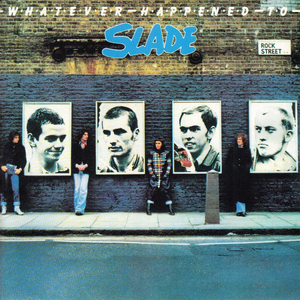
Whatever Happened to Slade is the seventh studio album by the British rock group Slade. It was released on 21 March 1977 by Barn Records, but did not enter any national album chart. By the time of the album's release, Slade's popularity was waning as were their record sales, which they acknowledged in the album's title. The glam rock movement, with which Slade was associated, had died, and the careers of other glam rock artists such as Mud, Gary Glitter and Sweet had hit the buffers. In Britain, where Slade had traditionally been most popular, the fashion of the day was punk rock. With this album, Slade stood their ground as a straight-ahead rock group; gone were their "glam" statements of the early decade.

Slade Alive, Vol. 2 is the second live album by the British rock band Slade. It was released on 27 October 1978 and did not enter the charts. Titled as the follow-up to the band's commercially and critically successful 1972 album Slade Alive!, the performances on Slade Alive, Vol. 2 were taken from the band's autumn 1976 tour of the United States and their spring 1977 UK tour. The album was produced by Chas Chandler.
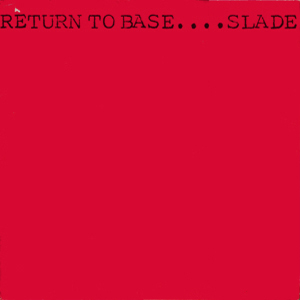
Return to Base is the eighth studio album by the British rock group Slade. It was released on 1 October 1979 by Barn Records, and did not enter any national album charts. At the time of the album's release, the band's success had waned and were receiving little fortune. Forced to play at small halls and clubs around the UK, the only income they were reliant on was Noddy Holder and Jim Lea's songwriting royalties. Their recent singles had sold poorly and they were no longer drawing in large audiences. Prior to their last-minute call up for the 1980 Reading Festival, they were on the verge of disbanding.
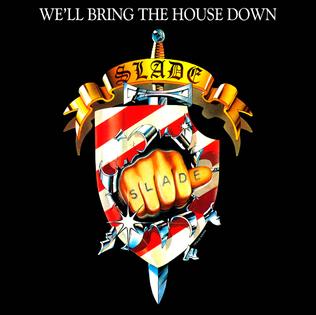
We'll Bring The House Down is the ninth studio album by the British rock group Slade. It was released on 13 March 1981 and reached No. 25 in the UK. The album was produced by Slade, except "My Baby's Got It" which was produced by Chas Chandler. The album was the first studio album released by the band after their successful appearance at the 1980 Reading Festival. In order to capitalise on their revival, Slade quickly compiled this new album, made up of some new tracks and some recycled ones, mainly from their failed Return to Base album of 1979.

"Mama Weer All Crazee Now" is a song by the British rock band Slade, released in 1972 as the lead single from their third studio album Slayed?. It was written by lead vocalist Noddy Holder and bassist Jim Lea, and produced by Chas Chandler. It reached No. 1 in the UK, giving the band their third number one single, and remained in the charts for ten weeks. In the United States, the song reached No. 76.
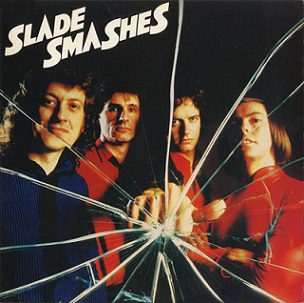
Slade Smashes is a compilation album by the British rock band Slade. It was released 1 November 1980 and reached No. 21 on the UK charts. The album was issued by Polydor in the wake of new interest in the band following their successful appearance at the 1980 Reading Festival, filling in for Ozzy Osbourne. The album featured most of the band's big hits from their early and mid 1970s heyday in the UK as well as three of the band's singles from post-1977. This collection, alongside the band's subsequent 1981 studio release We'll Bring the House Down, further cemented Slade's comeback in the UK and Europe.

Slade in Flame is a 1975 film starring the British rock band Slade. It was directed by Richard Loncraine and written by Andrew Birkin with additional dialogue by Dave Humphries. The film includes supporting roles by Tom Conti, Alan Lake and Johnny Shannon. In November 1974, the band's soundtrack album of the same name was released prior to the film.

"My Friend Stan" is a song by the British rock band Slade, released in 1973 as the first single from the band's fourth studio album Old New Borrowed and Blue. It was written by lead vocalist Noddy Holder and bassist Jim Lea, and produced by Chas Chandler. It reached No. 2 in the UK, spending eight weeks on the chart. The single was certified UK Silver by BPI in October 1973.
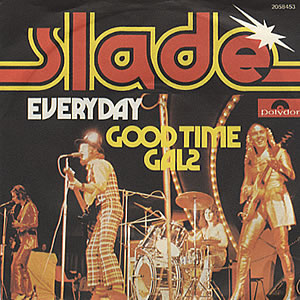
"Everyday" is a song by the British rock band Slade, released in 1974 as the second single from their fourth studio album, Old New Borrowed and Blue. It was written by lead vocalist Noddy Holder, bassist Jim Lea and his wife Louise Lea (uncredited), and was produced by Chas Chandler. It reached number 3 in the UK Singles Chart and spent seven weeks in the top 50. The single was certified UK Silver by BPI in April 1974, only three days after its release.

"Far Far Away" is a song by the British rock band Slade, released in 1974 as the lead single from the band's first soundtrack album and fifth studio album Slade in Flame, in promotion of the upcoming film of the same name. The song was written by lead vocalist Noddy Holder and bassist Jim Lea, and produced by Chas Chandler. It reached No. 2 in the UK, remaining in the charts for six weeks. The song was certified UK Silver by BPI in November 1974.

"How Does It Feel" is song by the British rock band Slade, released in 1975 as the second single from the band's first soundtrack album and fifth studio album Slade in Flame, in promotion of the film of the same name. The song was written by lead vocalist Noddy Holder and bassist Jim Lea, and produced by Chas Chandler. It reached No. 15 in the UK, remaining in the charts for seven weeks.
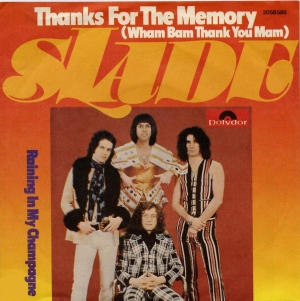
Thanks for the Memory (Wham Bam Thank You Mam) is a song by the British rock band Slade, released in 1975 as a non-album single. It was written by lead vocalist Noddy Holder and bassist Jim Lea, and produced by Chas Chandler. It reached No. 7 in the UK, remaining in the charts for seven weeks.
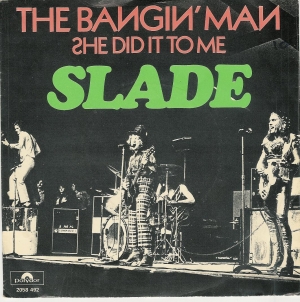
"The Bangin' Man" is a song by the British rock band Slade, released in 1974 as a non-album single. It was written by lead vocalist Noddy Holder and bassist Jim Lea, and produced by Chas Chandler. It reached No. 3 in the UK, remaining in the charts for seven weeks. The song was certified UK Silver by BPI for sales over 250,000 that same year.

"In for a Penny" is a song by English rock band Slade, released in 1975 as the lead single from their sixth studio album, Nobody's Fools. The song was written by lead vocalist Noddy Holder and bassist Jim Lea, and was produced by Chas Chandler. It reached number 11 in the UK Singles Chart and remained in the top 50 for eight weeks.
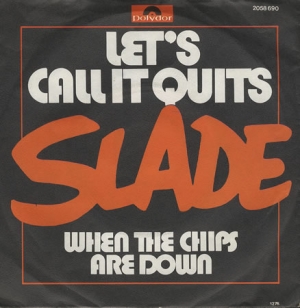
"Let's Call It Quits" is a song by the British rock band Slade, released in 1976 as the second single from their sixth studio album Nobody's Fools. The song was written by lead vocalist Noddy Holder and bassist Jim Lea, and produced by Chas Chandler. It reached No. 11 in the UK, remaining in the charts for seven weeks.

"Gypsy Roadhog" is a song by the British rock band Slade, released in 1977 as the only single from the band's seventh studio album Whatever Happened to Slade. It was written by lead vocalist Noddy Holder and bassist Jim Lea, and produced by Chas Chandler. It reached No. 48 in the UK.

"Rock 'n' Roll Bolero" is a song by English rock band Slade, released in 1978 as a non-album single. It was written by lead vocalist Noddy Holder and bassist Jim Lea, and was produced by Slade. The song failed to make an appearance in the UK Singles Chart.





















